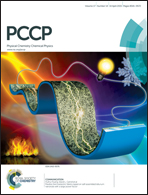Aqueous self-assembly of a charged BODIPY amphiphile via nucleation–growth mechanism†
Abstract
A new amphiphilic boron-dipyrromethene (BODIPY) dye 1 with a hydrophobic wedge at the meso-position and two hydrophilic cationic moieties at boron was synthesized. Temperature- and concentration-dependent UV/Vis spectroscopic studies in water were conducted to explore the self-assembly process of the dye. Detailed analysis of the data using two different models (developed by Van der Schoot et al. and Goldstein et al. respectively) for cooperative supramolecular polymerization indicates distinctly a nucleation–growth mechanism of the aggregation of dye 1 and the nucleus size (ca. 12–18 molecules) and a cooperativity factor (ca. 0.01) could be derived. Further investigation by transmission electron microscopy, scanning confocal microscopy, and X-ray diffraction revealed a unique vesicular morphology of the aggregates with multilamellar wall structure. Meanwhile, these dye vesicles exhibit unique optical characteristics, i.e. red-shifted sharp absorption band, narrowed emission linewidth, and increase in fluorescence quantum yield, as compared with the monomeric dye.


 Please wait while we load your content...
Please wait while we load your content...